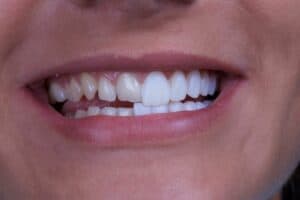Teeth are naturally and structurally strong and help to carry out activities such as chewing and smiling for a large part of our life. Tooth enamel is one of the body’s most vital parts, but breaking a tooth can also happen quickly. While tooth fractures may occur due to dental factors, some dental disorders may also cause this. If you are faced with a tooth fracture problem, tooth bonding can help you.
What is Dental Bonding?
Tooth bonding is an aesthetic procedure that helps repair cracked, broken, and damaged teeth. Furthermore, it can be used for teeth with discoloration, teeth with gaps between them, and teeth with unbalanced tooth lengths. A composite resin is used in tooth bonding to make your tooth look new. Unlike a crown used for fillings, the mixed color is similar to the tooth’s color and provides a natural appearance.
Smiling is one of the most beautiful feelings for many people, and many people want their smiles to be flawless, but cracked and broken teeth are also very critical for oral health. Tooth cracks and tooth fractures can cause problems in chewing, as well as significantly affect the health of the teeth around them.

Who Should Dental Bonding Be Used For?
Dental bonding is one of the best choices for minor injuries and small amounts of decayed teeth. If you have lost your tooth or a large part of your tooth, or if your tooth has been severely damaged, it would be a better choice for oral health to consider a dental implant instead of dental bonding. Dental implants entirely replace the tooth and its root with an implant and a porcelain crown.
At the same time, dental bonding is a good choice for people who are satisfied with the color of their teeth. If you want your teeth whitened, you must share this with your dentist before bonding. The dentist will choose a color tone that is compatible with your other teeth during the dental bonding process. If you do teeth whitening after tooth bonding, the color of the composite resin used during tooth bonding will not lighten.
Dental Bonding Procedure
Dental bonding is a procedure that doesn’t require anesthesia unless you need a filling or your dentist needs to change your tooth’s shape significantly. If you break it close to your teeth nerve, anesthesia can be applied as it can be painful. The first step is to choose a composite resin color as close to the color of your tooth as possible. The dentist will use a chart to make sure the selection is correct. Then the dentist prepares to adhere the composite resin to your existing tooth.
They start by creating a rough surface and applying a binder. The rough surface facilitates the adhesion of the liquid and the composite. Your dentist will then add the composite resin to the area and mold it to repair the damage. The resin is then hardened with the aid of a UV light. Finally, if the tooth causes discomfort, the dentist can make small changes to the tooth to achieve the appropriate setting.
Dental bonding is a procedure that does not require anesthesia unless you need a filling or your dentist needs to change the shape of your tooth significantly. If you break the tooth close to your nerve, it can be an anesthetic, as it can be painful. The first step is to choose a composite resin color that is as close to the color of your tooth as possible. The dentist will use a chart to make sure the selection is correct. The dentist then prepares to bond the composite resin to your existing tooth.
They start by creating a rough surface and applying a bonding agent. The rough surface facilitates the adhesion of the liquid and the composite. Your dentist then adds the composite resin to the area and molds it to repair the damage. The resin is then hardened with the aid of a UV light. Finally, if the tooth causes discomfort, the dentist can make minor changes to the tooth to achieve the appropriate setting.
Is Dental Bonding Risky?
Dental bonding is a reliable and simple outpatient procedure. There is no risk or negativity. Unlike veneers, the dentist doesn’t usually crush your tooth, so if you damage the composite resin, you can get help from your dentist to fix it without worrying about how your tooth looks. Composite resin also crumbles and breaks less often than veneers and crowns. For this reason, it is durable and does not cause continuous visits to the dentist.



